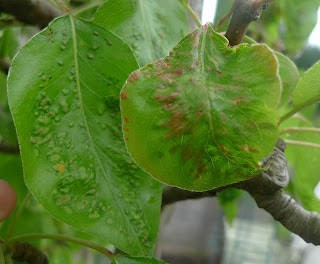In summary, this has been an absolutely terrible season, one of the reasons I haven't bothered posting much this year. To start with, no pollination as the insects didn't come out in the rain. The few pears that set are all abnormally small. Lots of scab on leaves and shoots. The quince set more fruit, but then a terrible attack of scab make everything drop off. The medlar set a lot of small fruit but it has now all browned off and rotted on the tree.
The plums were similarly affected, either no fruit set, or a small number of undersized fruit (which was all taken by the rogue squirrel anyway). The apples have done better, but with a fair amount of cracking or scab, and the early varieties have largely been spoiled by jay or squirrel damage before they were ripe enough to be picked.
This has been by far the worst year we've suffered here, normally only one or two susceptible pears are affected by fungal ills, but this year everything has suffered in some way or other from the terribly wet weather. So there will be no boxes overflowing with lovely clean, large, beautiful fruit this year. Very depressing and disappointing, I have been so ill this year it would have been lovely to have had something cheering to look forward to.
The plums were similarly affected, either no fruit set, or a small number of undersized fruit (which was all taken by the rogue squirrel anyway). The apples have done better, but with a fair amount of cracking or scab, and the early varieties have largely been spoiled by jay or squirrel damage before they were ripe enough to be picked.
This has been by far the worst year we've suffered here, normally only one or two susceptible pears are affected by fungal ills, but this year everything has suffered in some way or other from the terribly wet weather. So there will be no boxes overflowing with lovely clean, large, beautiful fruit this year. Very depressing and disappointing, I have been so ill this year it would have been lovely to have had something cheering to look forward to.















